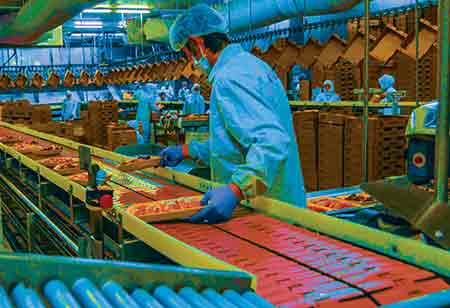THANK YOU FOR SUBSCRIBING
Be first to read the latest tech news, Industry Leader's Insights, and CIO interviews of medium and large enterprises exclusively from Food and Beverage Tech Review
Curtailing Risks Across Four Classes of Food Safety Hazards
While it’s hopeless to eliminate all food safety risks that lead to product recalls and

By
Food and Beverages Tech Review | Friday, October 27, 2023
Stay ahead of the industry with exclusive feature stories on the top companies, expert insights and the latest news delivered straight to your inbox. Subscribe today.
Food safety illnesses and injuries are assigned to biological, chemical, allergenic, and physical dangers, which can be mitigated with appropriate techniques & technologies.
Fremont, CA: In today’s complex food production environment, protecting products by preventing hazards that can cause food safety issues is essential. Food safety illnesses and injuries are assigned to biological, chemical, allergenic, and physical dangers, which can be mitigated with proper techniques and technologies. Those measures center on advanced inspection systems for physical contaminants that improve product safety and quality across critical control points.
While it’s hopeless to eliminate all food safety risks that lead to product recalls and potential consumer disease and injury, there are means to prevent and mitigate them. One precedence is identifying and diminishing hazards that pose risks to the safety and security of consumable products. Those hazards extend into four general categories: biological, chemical, allergenic, and physical. Next, look at the steps you can take to prevent them.
Biological hazards
Biological hazards come from possibly harmful microorganisms. These microorganisms can produce headline-making food safety illnesses such as Listeria, E. coli, Campylobacter, Clostridium Perfingens, and Norovirus.
Food manufacturers take steps such as pasteurization, irradiation, temperature management, and stringent sanitation and hygiene practices to hinder or reduce the risks from these and other biological hazards. While the new coronavirus isn’t a traditional foodborne pathogen, many health experts have recommended food handling, packaging, and transport measures.
Chemical hazards
Chemical hazards can derive from natural chemicals or improperly introduced manufacturing processes, such as cleaning substances, agricultural pesticides, animal drugs, food additives, and preservatives. Reducing these risks involves effective cleaning and sanitation, comprehensive employee training, proper storage and use of chemicals, and the appendage of chemicals that are Generally Recognized as Safe (GRAS).
Allergenic hazards
Allergenic hazards are connected to hundreds of product recalls a year and many food safety problems caused by reactions to typical allergens such as nuts, dairy, eggs, gluten, wheat, seafood, shellfish, and soy, among others. To prevent allergies, manufacturers must adhere to strict production and packaging techniques and precisely label their products with full ingredient descriptions and information.
Physical hazards
Physical hazards span impurities that can occur naturally with foods, like bone fragments in meat, and exterior materials, for example, glass, metal, tiny bits of dense plastic, or other items that become inserted in the food at some stage during processing and handling or manufacturing. Manufacturers can mitigate the risk of physical hazards by examining products with advanced x-ray machines deployed at crucial control points in the production and packaging process.
Inspection systems are a crucial part of manufacturers’ HACCP programs and help companies comply with food safety regulations and safety management systems, comprising the Food Safety Modernization Act (FSMA) and certifications according to the ISO 22000 standard. Robust software equipped with today’s inspection systems also provides greater traceability if questions occur about physical hazards in a product or batch.
Eagle must hone its inspection technologies to support food and beverage companies to prevent damaging recalls and food safety matters tied to natural and unnatural physical hazards. One instance is a new detector technology highlighted in the RMI 400 and Pack 400 HC for poultry processors. This modern detector technology represents a breakthrough in poultry inspection during increased demand in an uncertain global market.
In individual bags of chips – metalized packages – the software led to the detection of contaminants comprising 2.0 mm ceramic pieces, 1.5 mm low mineral glass fragments, and 0.4 mm stainless steel materials. Within the dairy industry, SimulTask PRO found and eliminated small metal pieces and gaskets in blocks of cheese that could have generated a large recall or, worse, consumer harm.
Utilizing complex supply and demand situations and the need to reduce the risk of vulnerabilities and recalls, advanced inspection systems protect products and manufacturers’ businesses from harmful and costly hazards.
I agree We use cookies on this website to enhance your user experience. By clicking any link on this page you are giving your consent for us to set cookies. More info







